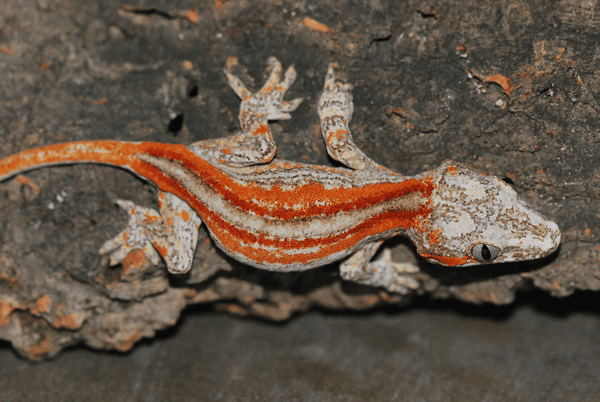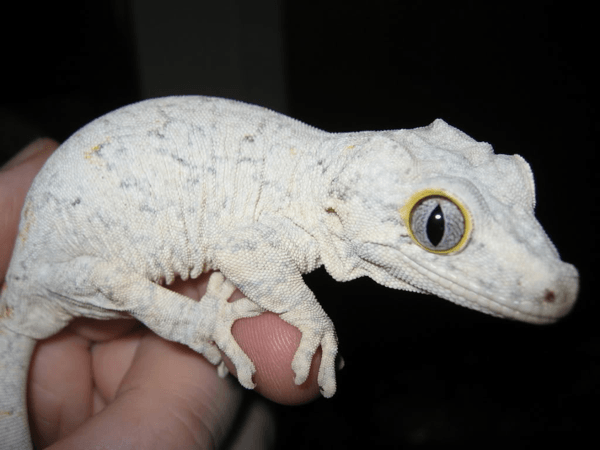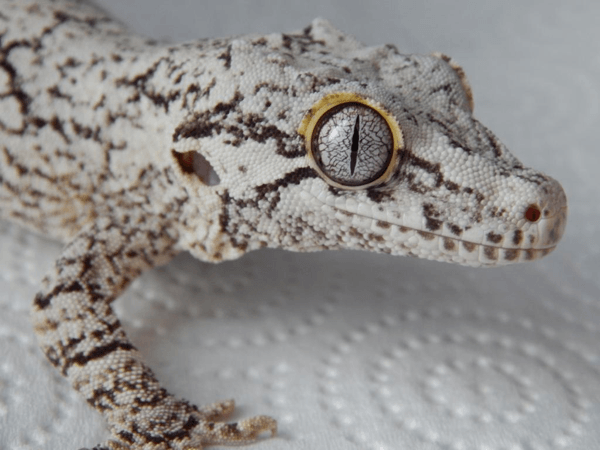Rhacodactylus geckos have taken a real hit in the past year. Stripped of the Crested and Sarasinorum Geckos (who are now in the genus Correlophus) as well as the Chahouha (now considered to be part of the Mniarogekko genus), what remains are the R. leachianus (discussed in the August 2012 installment of Three to Get Ready), R. auriculatus and R. trachycephalus. Despite these changes, Rhacodactylus keepers continue to be passionate about their geckos, as you will see from the accounts of the three experts.
As usual, the three Rhacodactylus gecko keepers have responded to the following questions:
- What species or morphs are you keeping?
- What got you interested in this species and where did you get your first one(s)?
- How are they set up? Describe your enclosure
- What do you find most interesting about them?
- What do you find to be the biggest challenge?

Mike Soltis
Rhacodactylus. The word itself is fun to say. Well, maybe it’s just me that thinks that but I’m joined by masses of folks that know that Rhacodactylus are fun to keep! “Rhacs” were among the first reptiles I began keeping when I started taking the hobby seriously nearly fifteen years ago. Nothing else had made me feel that special connection until I held my first Crested Gecko, and while no longer technically classified as Rhacodactylus as of this year, it was the gecko that set me on the path to where I am today in the world of reptiles! So let’s dive in and learn a few things about the Rhacodactylus in my collection!
I continue to work with Crested Geckos and Chahoua which until this year had always been considered Rhacs. I do have a pair of Rhacodactylus Leachianus, but since they were recently covered in Gecko Time and they are my only pair, I will focus on Rhacodactylus Auriculatus or the Gargoyle Gecko. Like many keepers, after working with Crested Geckos for a while I took the seemingly next logical step and turned my interest to Gargoyle Geckos. “Gargs” or “Aurics” as they are affectionately referred to in the hobby are easy to care for and fascinated me. I would own a pair and once I decided I liked them, I would begin working with them on a larger scale. This was my plan and shortly thereafter I purchased my first Auric at a reptile expo that I was “vending” at. Really I was just getting my feet wet with vending because I was given 25% of a table to sell my handful of creatures in exchange for marketing the owner of that table’s dry goods to pet stores that I had a relationship with. Little did I know, the Auric I picked up that day would grow into what is referred to as a Ghost morph (an almost solid white) and would be the gecko featured on my first official display / website banner. She was awesome and certainly responsible for my decision to expand my collection of Gargoyles!
Part of the beauty of owning Aurics is that their care is remarkably simple. In the beginning I went crazy with glass enclosures. When you start getting older and your back starts telling you that 40-gallon breeder tanks will eventually have your chiropractor on speed dial, you discover that plastic tubs are the way to go! Lightweight, easy to clean and they hold humidity really well. Each 56-quart enclosure is lined with paper towel and has plastic vines and leaves wrapped around appropriately-sized PVC pipe and secured with waterproof electrical tape at both ends. I include a cork bark slab which leans up against a Ziplock container which serves as the lay box. This is filled with about two inches of thick-grade Perlite which is kept moist. I have used this method for many years without incident. I also use Perlite to incubate the eggs, all at room temperature.
I think there are a few things about Gargoyle Geckos that are quite interesting. They have amazing-looking eyes! The striped and reticulated patterns are both distinct and beautiful and the coloration of stripes, blotches and even the base coloration are quite striking.
Challenges exist in all manners of gecko-keeping, even regardless of the level of experience. The one thing about Auriculatus is that they are notorious toe and tail nippers. Breeding can take a physical toll on animals with regard to calcium production and stress, and when you add in the biting, there can be some pretty scarred animals in breeding populations. I never raise youngsters together, not even clutch mates. Sure, the tails grow back but I never like having an animal lose a tail and certainly take pride in the fact that all of my aurics have all their toes and tails when they move on to new homes!
All in all, owning Gargoyle Geckos is a wonderful experience for beginner and advanced keepers alike!

Aliza Arzt
I have one R. leachianus (Igor) and a male and two female gargoyle geckos. In addition, I still have 6 of the 9 juvenile gargoyle geckos I produced this season, though I hope I won’t have them for too much longer (any interest out there?).
Although I had known for awhile what gargoyle geckos were, I didn’t get bitten by the Rhac bug until I vended at one of the big New England reptile expos and saw some gargs that just hit the spot with me. They were fired down, pale gray geckos with prominent orange stripes. Something about the gray and orange and the fixed wide-eyed stare got to me. I wasn’t prepared to purchase one then and there, but I couldn’t get them out of my mind. A few months later I convinced my family to detour on a road trip so I could visit Steve Cemelli of Leapin’ Leachies and pick up my first garg. Orange stripe, of course. To this day, I actually prefer my gargs fired down to fired up. Eventually I acquired another female and a male, all red or orange stripes, and garg breeding was in business.
The conventional wisdom is not to keep gargoyle geckos together since they are known to be aggressive with each other. Since I keep many of my other species together in small groups, I experimented a bit with gargoyle groupings. I discovered that my two females could co-exist, the male and one of the females were fine, but the male and the other female were a no-go (he kept biting her head). Currently, my male and one female reside in an exo-terra 18″x18″sx18″ tank and the second female is alone in a 12″x12″x18″ exo-terra. The larger tank is planted with a hydroton/vinyl/coco fiber substrate and a single pothos plant. I prefer not to over-plant the gargoyle tank since the female will probably be tearing up the substrate when she lays her eggs. The decor is completed by two large slabs of cork bark, where the gargs spend most of their time and a feeding ledge. The lone female’s tank is not planted, since she is in a location that’s not amenable to additional lighting, but she has an interesting background with hollows and ledges that provide many compelling hiding places.
My juvenile gargs are kept individeually in 6qt shoebox sized tubs with paper towel substrate. Each tub has a hide, a piece of cork bark for climbing, a small food dish and a water bowl.
I continue to be fascinated by the color and pattern of the gargoyles. I prefer the stripe pattern to the reticulated. Imagine my surprise when two striped gargs produced a reticulated baby. That pattern is now a bit more interesting to me too, but I still like the stripes better. The color development in the juveniles as time passes is also very interesting. The color changes and the fired up/fired down phases mean that when I open my juveniles’ tubs, I don’t know whether or not I’ll recognize what in there on a given evening!
Garg-care presents few challenges, since they are so easy to keep. Besides not getting peed on every time I pick one up, I suppose my biggest challenge is designing a planted enclosure that allows the garg to lay her eggs and me to find the eggs without the tank getting totally torn up every time. I’ve partially solved this problem by planting the pothos toward the back of the enclosure and leaving lots of clear area for egg laying. Since I can’t see the eggs through the garg’s belly (as I can with the leopard geckos) I have to resort to weighing the females every evening during the breeding season and waiting for that 5 gram weight drop which lets me know that now I should start digging.

Paul Morlock
My collection is currently centered around Rhacodactylus auriculatus. I work with chahoua and a few ciliatus too but I have found the auriculatus to easily be my personal favorite. I had my first real exposure to these geckos in early ‘02 and immediately fell in love with them. I remember their big beautiful blue eyes caught my attention first. Then, once I began to see to amazing variation they displayed in color and pattern combined with their bearded dragon like tolerance for handling and ease of care, I had to have more. The more I got, the more I saw how amazing gargoyles actually are.
I’ve always felt I needed to keep large numbers in order to really understand a species as a whole. Because of the number of animals I keep my setups are very simple. All non breeding geckos are housed individually in plastic tubs. Plastic tubs are not only easy to clean and sanitize but they tend to hold the humidity above 50% very well which I believe is the most important aspect of their care, particularly for the young. I use paper towel and newspaper as substrate to aid in monitoring the overall health of all my animals and I use pressed egg crate flats for hiding and climbing. The large surface area of the egg crates is ideal for maintaining maximum usable space as well as out of sight-line hiding both high and low within the enclosure. As a bonus, cleaning is as simple as “out with the old in with the new”. All geckos have a food and fresh water dish. Breeder tubs have multiple food and water dishes to help minimize competition. Breeder setups have a calciumD3 lick available at all times as well as multiple nest boxes. Most of my breeder groups consist of one male and three females, although I’ve successfully kept groups as large as one male and seven females. I do find housing my adults together year round minimizes conflict, tail damage or loss.
I’m not sure I can pick one thing that’s most interesting about them. There are so many things that make them a perfect gecko to me. The amazing diversity in color and pattern, their awesome laid back personalities, their large size and the ease of their care are all excellent attributes. I guess if I have to pick though, it would be their range in color. The extremes of light and dark changes they can display daily and the amazing increase in bright reds, oranges and yellows some can get as they mature is incredible. They never cease to amaze me and every individual seems to have something that captures the eye.
These geckos are so easy to keep that it’s hard to find any real challenge, but I guess the hardest thing for many is maintaining proper humidity without keeping a wet cage. A fruit based diet in a wet cage can create mold pretty darn quickly. I have a room dedicated to my geckos which enables me to just run a humidifier making it a bit easier. I always recommend a larger water dish to begin with and I personally only recommend spraying when it’s absolutely needed. Gargoyles will drink from a bowel so spraying isn’t necessary for drinking, only for maintaining proper humidity. If you have to spray use a nice fine mist.

Aliza Arzt is a home care speech therapist living in the Boston area. She has been breeding leopard geckos since 2005 and has also been successful in breeding Coleonyx, African Fat Tail, Gargoyle geckos and, very recently, L. williamsi. Other interests which she pursues in her copious free time include work in ceramics, practicing aikido and surfing the internet.
Paul Morlock has had a life-long love of reptiles. He has been keeping and breeding various geckos, lizards and snakes for more than 22 years. He started a selective breeding program in 2008 concentrating solely on Rhacodactylus auriculatus followed by the opening of RhacHouse LLC in early 2012.
Mike Soltis is the owner of Dragontown Reptiles and works with a variety of geckos. He has been in the hobby for fifteen years and can be found working expos in New York, New Jersey, Massachusetts and New Hampshire. Visit his site: www.dragontownreptiles.com or e-mail him: [email protected]



What a very interesting and well written article this is. I now want to try to keep some myself. I learned a lot; which is always nice. The pictures were breath taking and had me dreaming of having a collection of my own.
Thank you for the great information.
GO TO LOVE THEM RHACS!!!!
Don’t forget R. trachyrhynchus lol!
Didn’t forget them, but no one was keeping them. We can always use another article . . .
I’ve just recently got into gargs, I’ve really enjoyed them and I’m getting more this weekend!